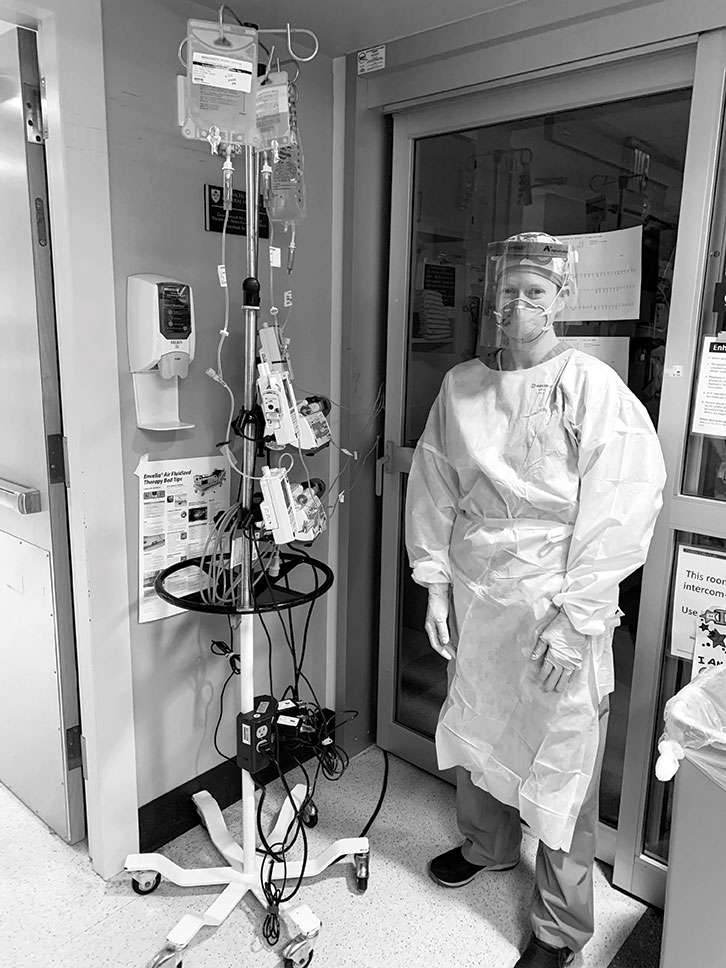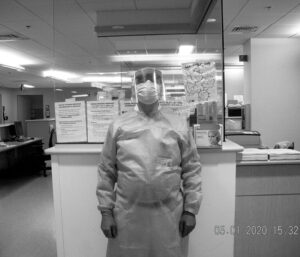Health care workers with Trinity ties stand tall
By Mary Howard
Last spring during the initial surge of the pandemic, The Trinity Reporter spoke with seven members of the college community on the front lines of health care to learn how COVID-19 has changed their working lives. These professionals continue to battle through an unprecedented time, using their expertise to save the lives of others.

When early models predicted Boston to be an epicenter for COVID-19, Massachusetts General Hospital began preparations that included increasing the number of intensive care unit (ICU) beds for critically ill patients. For Phoebe Yager, M.D., ’92, chief of the hospital’s Division of Pediatric Critical Care Medicine, and her team, that meant “redeploying” their pediatric ICU to accommodate adult COVID-19 patients.
While their pediatric patients were transferred to other facilities, Yager and her colleagues stayed put. “We felt, as a high-functioning team, we would be more successful together than being deployed to other units,” she says.
She spent most of March preparing her team to tackle COVID-19. Staff safety was a top priority. There were eight-hour Zoom meetings and constant revisions to schedules and staffing models, she says. “It felt like building a plane while flying it.”
Transitioning from treating children to adults while implementing COVID-19 care recommendations was a challenge, says Yager. But keeping her team together minimized unnecessary changes to personnel and the environment. “It was the most important factor in our success,” she says, adding, “Watching each patient graduate from our ICU has been emotional and heartwarming.”

When COVID-19 patients are released from Morton Hospital in Taunton, Massachusetts, where James Davenport ’77 is a nurse, the theme song from the movie Rocky is played over the intercom. “It’s encouraging,” says Davenport, who has 33 years in the profession. “It shows us that we’re beating this illness.”
In response to the pandemic, the hospital administration decided to admit COVID-19 patients exclusively, he says. “This helps focus care and the use of personal protective equipment [PPE]. It also helps nurses and doctors see patterns of the illness, which leads to better treatments and outcomes.”
Davenport works in the hospital’s emergency room and also treats critically ill COVID-19 patients in its ICU. Many of them are older and have underlying health issues, he says. “In the advanced stage, patients present with low blood pressure and multiple organ failure, he says. “It ravages the entire body.”
Though Davenport is in close contact with these patients, he’s not concerned for himself but for the families that cannot be with their loved ones at such a critical time, noting that the presence of family members is a humanizing factor. “They help us fill in the gaps in our patients’ lives,” he says.

When Sara Stevens ’06 first read reports about the virus coming to the United States, she, too, became worried—not for herself, but for her patients. “It was like watching a train come off the track, knowing there was nothing we could do,” she says. A nurse practitioner at Mass General Cancer Center, Stevens works predominately with lung cancer patients, who are considered high-risk for complications of COVID-19.
“I had a very real concern about how they would get their care in a safe and effective way,” she says. Clinic protocols changed rapidly, and she began to see some patients through virtual visits, reserving face-to-face contact for those needing chemotherapy or other direct care. Though she misses close contact with all of her patients, she appreciated a special virtual visit with a woman she has followed for three years. “After the appointment, she showed me her garden and all the flowers she has told me about over the years,” says Stevens. “That couldn’t have happened in the office.”
An internist and president of Providence Medical Associates in Los Angeles, Elizabeth Sander, M.D., P’16 also misses patient contact. In addition to being responsible for overseeing the medical group, with its 17 sites and 200 providers, she sees patients two days a week. With COVID-19, these visits are conducted virtually, as are her meetings. “The sense of isolation is often overwhelming,” she says. “I forget how social we are.”
COVID-19 also affects Sander’s family life. Because of travel restrictions, she can’t see husband John DiFiori, M.D., P’16, a sports medicine specialist at a hospital in New York City. Their daughter, Monica DiFiori ’16, in her third year at Temple University’s Lewis Katz School of Medicine, traveled to California to take her medical boards. Due to the pandemic, the exams were canceled, and she was unable to return to medical school in Philadelphia. “It’s a strange time,” says Sander.
Professionally, her biggest challenge was dealing with all the uncertainty in the early stages of the pandemic. Information about the virus was coming in so quickly that Sander and her staff constantly had to regroup. “What worked in one moment completely changed three hours later,” she says. “That’s very unsettling for people who are scientifically trained.”
A pediatrician and specialist in the genetic diseases that plague the Amish and Mennonites of Pennsylvania, D. Holmes Morton, M.D., IDP’79 is experiencing a unique set of challenges during the pandemic. His goal is to protect his vulnerable patients from contracting COVID-19 by finding pre-symptomatic carriers who may infect others in this insular population. But, he says, that’s not easy among the Plain People, who do not consume media and often are unaware how to protect themselves.
Despite its rural location, Morton’s Central Pennsylvania Clinic in Belleville, Pennsylvania, offers cutting-edge COVID-19 testing and, in an attempt to increase access with a drive-through service, accommodates horse-pulled buggies. Still, he says, “we are undercounting, undertesting, and little is being done to stop the spread of COVID-19 in the Plain communities … gatherings of all kinds continue to feed the [virus].”

For Raphael Viscidi, M.D., ’70, P’05, a virologist and professor of pediatrics at Johns Hopkins University School of Medicine, second-guessing viruses is all in a day’s work. His research interests include human coronaviruses. When COVID-19 first appeared, Viscidi became curious about why it can cause severe infections in older people but often spares children. “This is dramatically different than other respiratory viruses, which infect the elderly and the very young.” This is because young children lack exposure to disease, which means they have few protective antibodies, Viscidi explains.
“But some viruses, like the dengue virus, stimulate enhancing antibodies. The first time you get infected, you’re OK, but the second time, you might go into hemorrhagic shock.” He thinks the reason older people are hit harder may be because they have enhancing antibodies due to repeated exposure to coronaviruses, which cause the common cold; he’s testing his theory in the lab using serum samples.
Clinical research coordinator Zachary Bitan ’17, M’18 and his colleagues at Columbia University Irving Medical Center are taking a different look at antibodies and their role in COVID-19. Through a randomized, controlled trial, they are giving critically ill COVID-19 patients transfusions of plasma from individuals who have recovered from the virus. Their hope is that antibodies contained in the plasma will help sick patients fight the disease.
Bitan—who plans to begin his studies at Technion American Medical School in Israel in October—oversees recruitment of plasma donors and coordinates the delivery of plasma to ICU units. “Nurses and support staff are the true heroes of this pandemic,” he says. “When I am in the ICUs, I am in awe of how the nurses care for COVID-19 patients as if they were their own family.”
How does ICU nurse Davenport feel about being seen as a hero? While he appreciates the outpouring of public support, he doesn’t feel like one. “I’m just doing my job,” he says.
Sander echoes his sentiment: “This is what we do; this is what we signed up for.”
All in this together
Trinity alumni in a variety of fields—in addition to health care—are helping others during the pandemic through their jobs or volunteer work. The following list showcases just a sample of Bantams doing good, in ways large and small.
Mona Deng ’16: rising fourth-year med student at the David Geffen School of Medicine at UCLA established LA COVID Volunteers (LACV) along with classmates in March, organizing volunteers to support health care workers
Rhoden Monrose ’09: founder and CEO of CariClub, which, in partnership with Charity Navigator, started Community Inclusion Fund to raise $500 million to help vulnerable communities that have been disproportionately impacted by COVID-19
Jim Murren ’83: former MGM Resorts International CEO leads Nevada’s COVID-19 Response, Relief, and Recovery Task Force
Brooke Raymond ’90: coordinates delivery of PPE from overseas to hospitals through the nonprofit Operation Mask Lift
Shawn Wooden ’91: Connecticut state treasurer calls on companies to retain workers, provide paid leave during the COVID-19 pandemic
To learn about more alumni who are giving their all during this time, please visit the Virtual Long Walk.
